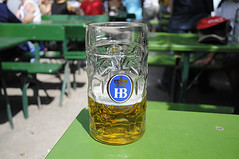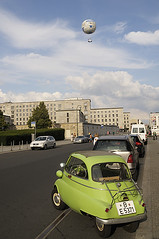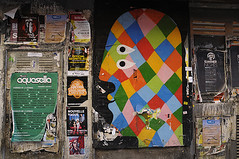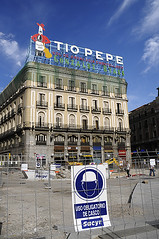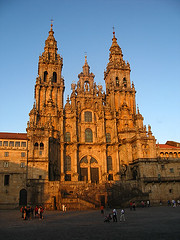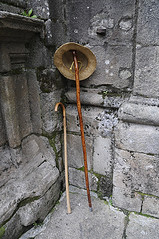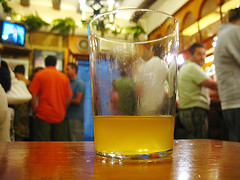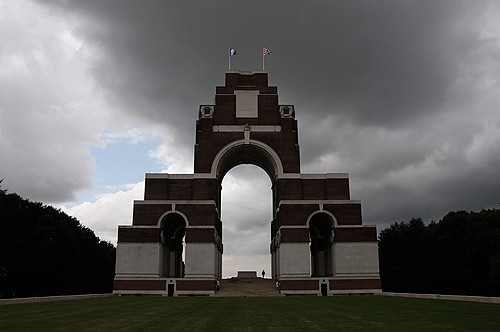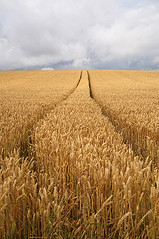


San Sebastian is one of those places that has you gazing longingly into the windows of estate agents within hours of arriving. It's such a beguiling mixture of climate, beauty, people and food. Blimey, the food. There's such a load of cobblers written about San Sebastian - despite what the sunday broadsheets say, every bar does not deserve a Michelin Star - but the overall standard of nosh is exceptionally high. I'm not going to pretend to be an expert on tapas - or
pintxos, as the Basques call them. I couldn't even tell you what most of them were called, but drifting from bar to bar in the Old Town scoffing whatever is on offer, is one of life's finest things. It's not cheap, but then it shouldn't be either - apart from the ever-present jamon, the pintxos are mainly seafood with an emphasis on cod, sardine, anchovy and tuna. The fruits of the sea are a matter of fierce pride for the famously outward-looking and seafaring Basques. EU quotas seemed to have decimated the number of fishing vessels in the harbour since our last visit, but it still buzzed with maritime activity and is still a focal point for the locals. Cod and tuna in particular are becoming a rarer and much more difficult and dangerous catch. To paraphrase Walter Scott, it's wasn't fish we we're eating, it was men's lives, so we made sure we finished every morsel, as we would in Whitby or Newlyn. Every bar we visited was pretty good, but the real standouts were the tiny
Bar Tamboril (warning: annoying, overdesigned website) on Calle Pescaderia,
Bar Aralar at 10 Calle Puerto which was so boistrous and friendly that we kept returning, and the place next door where I had
anguillas, a pinxto of tiny eels so spectacularly gorgeous I'm still thinking about it.
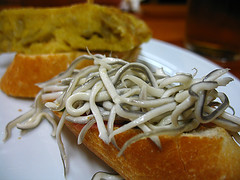
Funny how beer you'd tip down your sink at home tastes just brilliant when you're on holiday - even something from Cruzcampo called (I think) 'Polar', a sort of Iberian Fosters Ice. Cruzcampo, along with their owners Heineken rule the roost here, with Amstel and the ubiquitous Mahou. Personally, I've always found Mahou a pretty decent drink home or away, but it was good to find the odd bar with a Pilsner Urquell tap.
Along with Asturias and Galicia, the Basque Country is one of Spain's cider regions. We'd missed the season for visiting San Sebastian's out-of-town cider houses, but we tracked some
sidra down at anchovy-specialist Bar Txepetxa (picture in the post below) at 5 Calle Pescaderia. As in Asturias, It was poured from shoulder level by the barman to 'aereate' the liquid. I'm not sure this bit of theatre has any effect on the taste, but I'm not complaining. It was astringent, sour and made you want to suck your cheeks inside out - and utterly delicious. The perfect palate cleanser for more pintxos and more cerveza and more tinto.

We ended up spending a day longer than we planned in San Seb. The doughnut at the hire car agency in Lille forgot to give Our Lad his licence back, so the next leg of our journey was spent not in a Parador near Gijon, but rattling across country in a RENFE train that stopped at every lamppost and farm. Should you find yourself in a similar predicament, be assured that an extra 24 hours in this lovely city is definately no hardship.
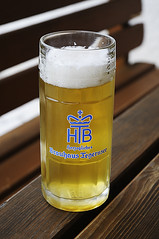 3) Tegernseer Spezial (Herzoglich Bayerisches Brauhaus Tegernsee) (bottle and draught): The colour of august wheat, no discernable nose that I could detect. Clean, crisp. Very slightly tart with short 'buttercup syrup' finish. Refreshing. A couple of days later I had this vom fass in Bad Tolz. The waiter claimed it was "best beer in Germany - better than Augustiner!". While I can't agree with that, I preferred it to the bottled variety - it was full of sweet malt and fresh grassy-ness (if that's even a word), and a quite superb swig.
3) Tegernseer Spezial (Herzoglich Bayerisches Brauhaus Tegernsee) (bottle and draught): The colour of august wheat, no discernable nose that I could detect. Clean, crisp. Very slightly tart with short 'buttercup syrup' finish. Refreshing. A couple of days later I had this vom fass in Bad Tolz. The waiter claimed it was "best beer in Germany - better than Augustiner!". While I can't agree with that, I preferred it to the bottled variety - it was full of sweet malt and fresh grassy-ness (if that's even a word), and a quite superb swig. 4) Badische Staatsbrauerei Rothaus Tannenzaepfle (bottle) : Slightly metallic nose. Darkish gold colour. Lots of heavy but quite sweet malt and hoppiness sustained into a long finish. Maybe it's that wonderful label, but notes of pine and resin kept creeping in. A real mouthful, anyway. I'd brought one bottle with me, only to find that Dan had got in a whole crate. Prost!
4) Badische Staatsbrauerei Rothaus Tannenzaepfle (bottle) : Slightly metallic nose. Darkish gold colour. Lots of heavy but quite sweet malt and hoppiness sustained into a long finish. Maybe it's that wonderful label, but notes of pine and resin kept creeping in. A real mouthful, anyway. I'd brought one bottle with me, only to find that Dan had got in a whole crate. Prost!


